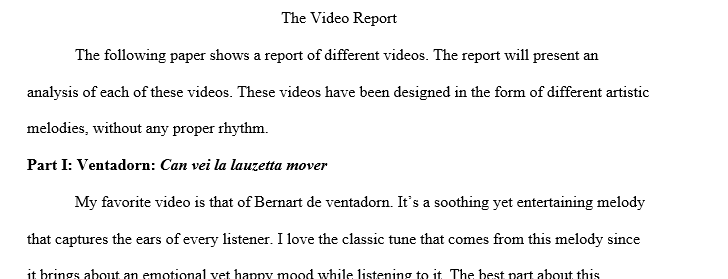Compare the two performances of music by Medieval composer and troubadour Bernart de Ventadorn that are provided below. Which is your
For this video report, consider the following and provide your response in the form of a short essay for each part.
Part I: Ventadorn: Can vei la lauzetta mover
According to your textbook and my PowerPoint presentations, the music of the troubadours was generally monophonic with improvised accompaniments. This means that only the melody (without rhythmic notation) survives to this day. We know that the instrumental accompaniment was present (probably improvised by jongleurs). Compare the two performances of music by Medieval composer and troubadour Bernart de Ventadorn that are provided below. Which is your favorite and why? Which one do you feel is the more “traditional” performance. Why do you feel that? Consider the translation of the text below. What elements/emotions of the text do each of the performances bring out? How are the performances similar and different?
When I see the lark beat his wings
for joy against the sun’s ray,
until he forgets to fly and plummets down,
for the sheer delight which goes to his heart,
alas, great envy comes to me
of those whom I see filled with happiness,
and I marvel that my heart
does not instantly melt from desire.
Alas, I thought I knew so much about love,
and really I know so little,
for I cannot keep myself from loving her
from whom I shall have no favor.
She has stolen from me my heart, myself,
herself, and all the world.
When she took herself from me, she left me nothing
but desire and a longing heart.
Never have I been in control of myself
or even belonged to myself from the hour
that she let me gaze into her eyes-
that mirror that pleases me so greatly.
Mirror, since I saw myself reflected in you,
deep sighs have been killing me.
I have lost myself, just as
handsome Narcissus lost himself in the fountain.
I despair of women,
no more will I trust them,
and just as I used to defend them,
now I shall denounce them.
Since I see that none aids me
against her who destroys and confounds me,
I fear and distrust them all
for I know well they are all alike.
In this my lady certainly shows herself
to be a woman, and for it I reproach her,
for she wants not that which one ought to want,
and what is forbidden, she does.
I have fallen out of favor
and have behaved like the fool on the bridge;
and I don’t know why it happened
except because I tried to climb too high.
Mercy is lost, in truth,
though I never received it,
for she who should possess it most
has none, so where shall I seek it?
Ah, one who sees her would scarcely guess
that she just leaves this passionate wretch
(who will have no good without her)
to die, and gives no aid.
Since with my lady neither prayers nor mercy
nor my rights avail me,
and since she is not pleased
that I love her, I will never speak of it to her again.
Thus I part from her, and leave;
she has killed me, and by death I respond,
since she does not retain me, I depart,
wretched, into exile, I don’t know where.
Tristan, you will have nothing from me,
for I depart, wretched, I don’t know where.
I quit and leave off singing
and withdraw from joy and love.
Version 1: Ensemble Alla Francesca
Version 2: Ensemble Unicorn
PART II: John Dowland: Flow My Tears (lute song)
Compare three performances of music by Renaissance composer John Dowland’s. The first performance is by Valeria Mignaco, soprano and Alfonso Marin, lute. The second performance is the solo lute work Lachrimae, which is written also written by Dowland and uses the same melody. The third performance is by a singer who made his career in popular music before sampling the works of John Dowland and learning to play the lute himself. In addition, the final clip includes an interview in which Sting interprets and reflects upon the song.For your review of this work, include information about the performers themselves, the lute song of the Renaissance (you will have to search the Internet for facts), and finally, your comparison and evaluation of the three performances. To conclude this portion of your assignment, I would like your opinion on which of these three performances you believe is the most effective and appealing and why you believe this is the case.
Performance No. 1: Valerie Mignaco and Alfonso Marin
Performance No. 2: Andrea Damiani
Performance No. 3: Sting (Gordon Sumner)
Your response should take the form of a 2-3 page essay detailing your responses to the questions above. It should represent your best scholarly written English and reflect you at your most thoughtful. A superficial response will not be sufficient.
Answer preview for Compare the two performances of music by Medieval composer and troubadour Bernart de Ventadorn that are provided below. Which is your

571 Words